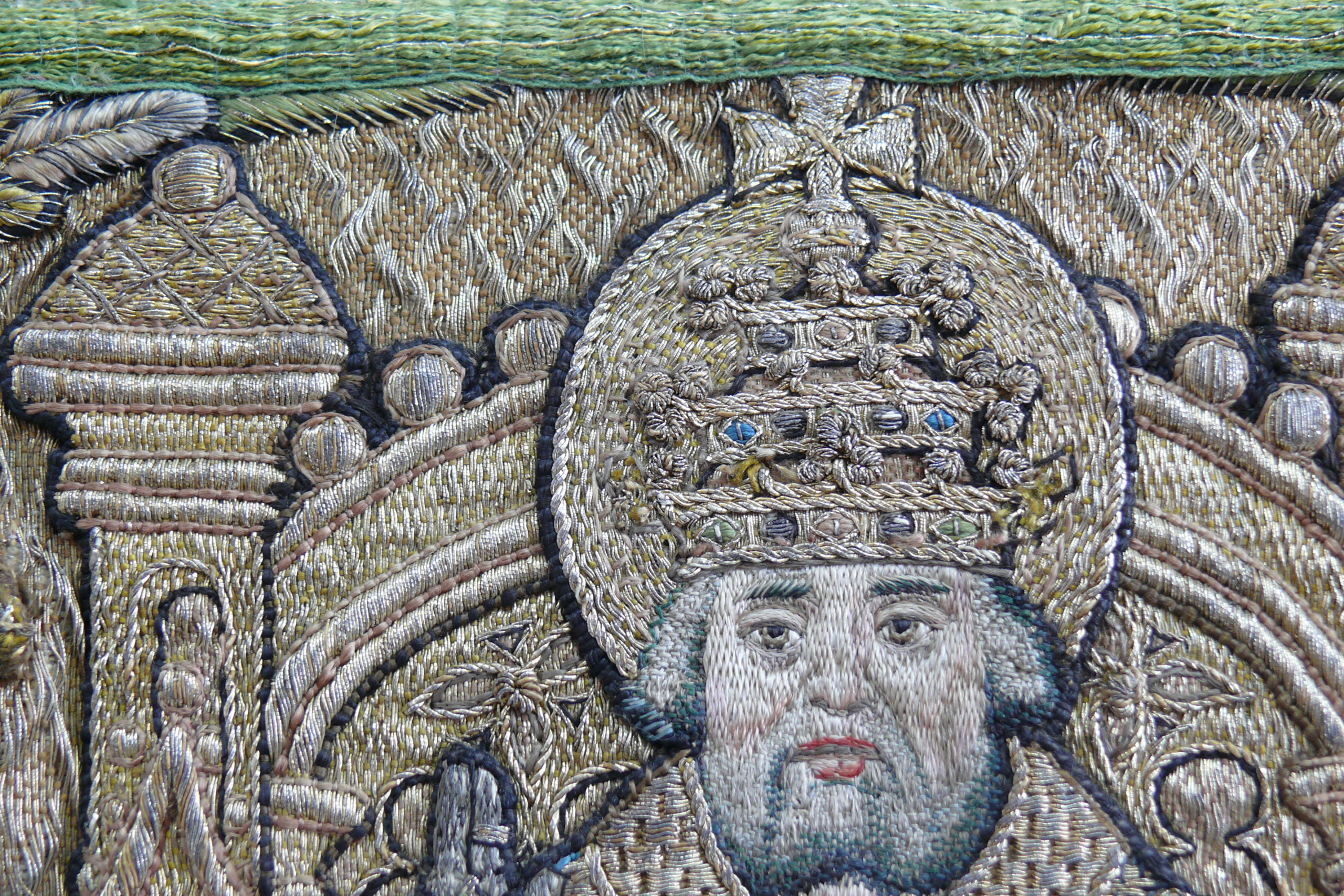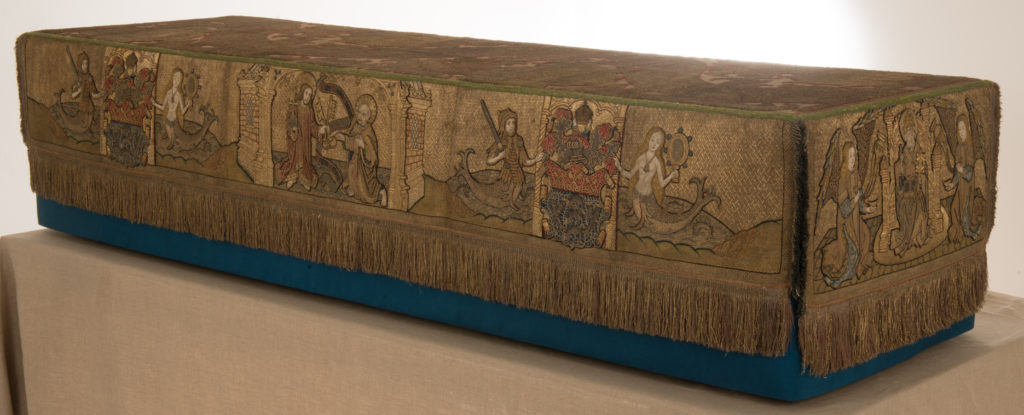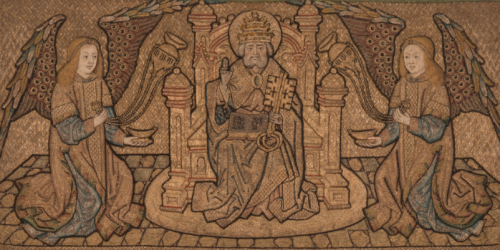
The Victoria & Albert Museums’ latest major exhibition, ‘Opus Anglicanum: Masterpieces of English Medieval Embroidery’ opens on October 1st featuring rare and outstanding examples of ‘Opus Anglicanum’ (English work) from the 12th to the 15th Centuries. The Fishmongers’ Funeral Pall, one of The Worshipful Company of Fishmongers most priceless treasures, is amongst this stunning display. In 1873 Walter Thornbury wrote enthusiastically of the Pall, “In the style of ornament, workmanship, and materials, this is one of the most superb works of its kind of ancient art, and in this country, as a relic of the old Catholic faith, has probably no parallel.”
The Pall has been featured in the October issue of The World of Interiors among a number of superb examples of this embroidery work. It is a lovely sneak preview of what is to come in the V & A’s fantastic exhibition.
The Pall, dating c.1512-38, came to our Studio in 2014 for mounting and minor conservation. We were amazed by its condition, the gold and gilt thread and coloured silks still vivid after five centuries. The Pall had previously been conserved in the 1980s and the conservation had held up well. Our work focused mainly on creating an inert supportive mount on which to safely display the embroidery in its new display case. We will be adding a case history about the mount and display case soon but for now the focus is on the pall itself.
While the Pall was in the Studio for conservation, Hazel Arnott, our conservator who is also a professional embroiderer, was able to study it more closely and put together an in depth report on the embroidery for the Fishmongers Company entitled, “A Study of the Embroidered Fishmongers’ Company Pall”. The examples below show the extraordinary detail and skill the embroiderers put into each element to depict not only richness and texture but facial expression and emotion.
Mermaid holding a mirror. The mermaid’s tail is worked in couched gold Passing (a fine metal wire wrapped around a silk core thread), with details worked in coloured silk floss Split/Stem stitch and the outlines of the scales worked in gold Twist. Her arms and face are worked in shaded Burden stitch in coloured silk floss. Extra details of the mermaid such as her fingers, elbows and facial features are worked in directional Split stitch. Her eyes are worked in Satin stitch in coloured silk floss. Her necklace is couched gold Twist with coloured silk floss jewels worked in padded Satin stitch. Her hair consists of undulating lines of single couched gold Passing alternating with lines of silk floss Split stitch. Her mirror is worked in silver Passing with coloured silk couching depicting the reflection of the Mermaids’ face. The depiction of the “reflected” face of the mermaid in her mirror is reminiscent of one of the The Lady with the Unicorn tapestries woven around 1500.
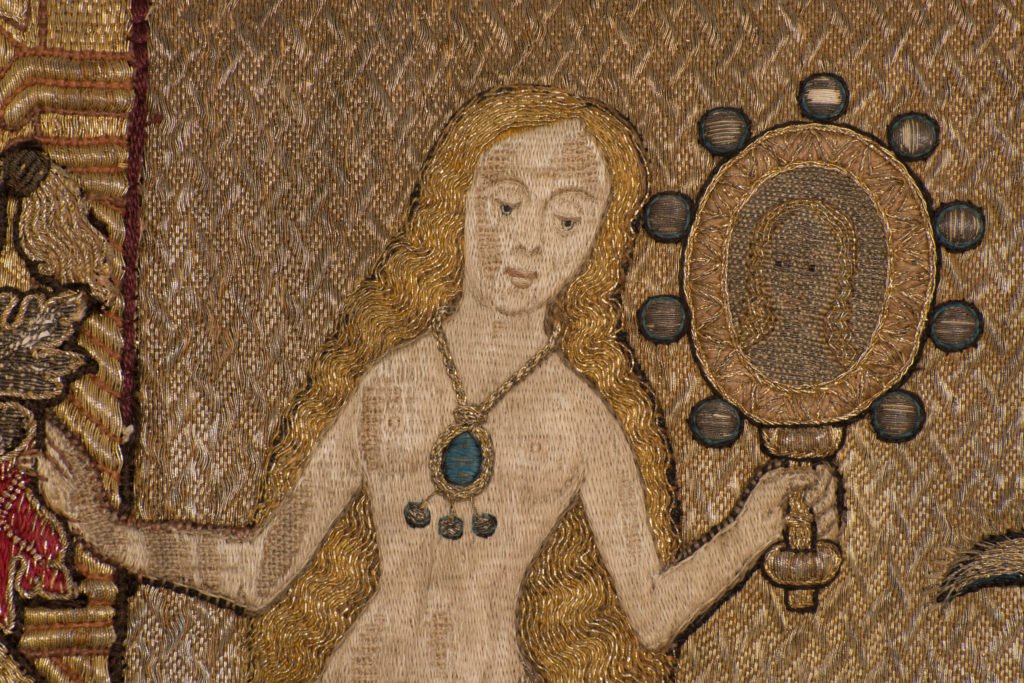
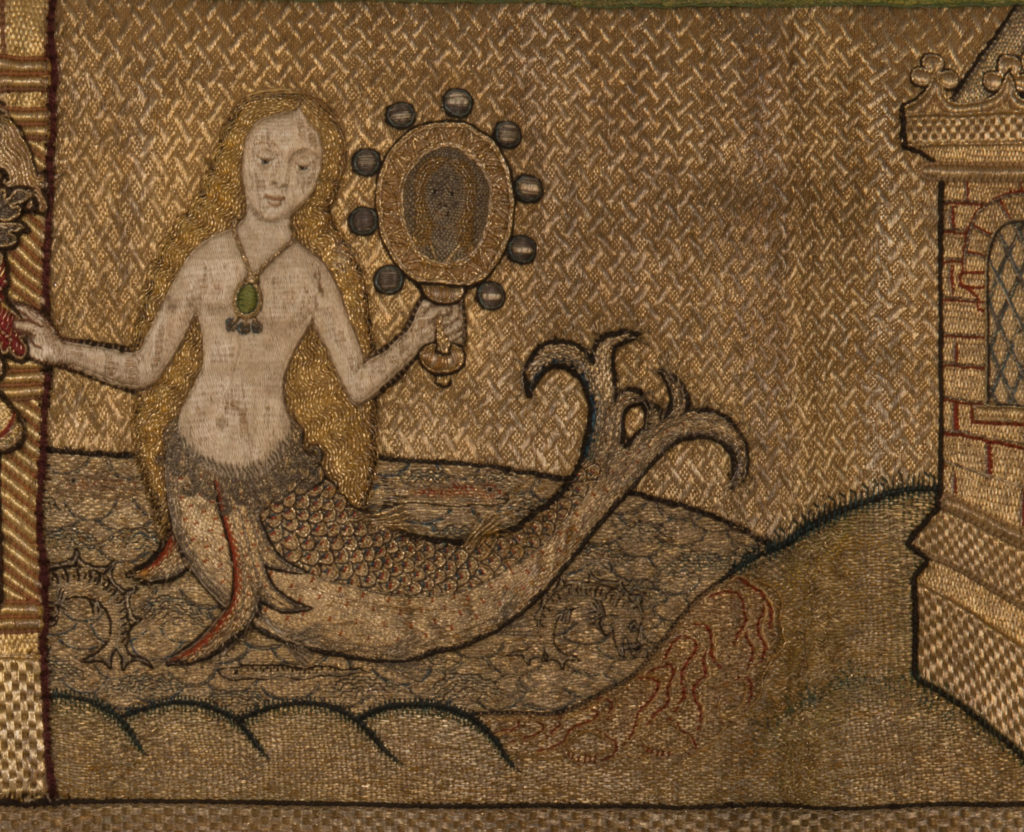
More commonly only one type of Twist is used and in a single line but on the Pall, lengths of both Twists have been used. The headdresses of the Angels and the frames of the Mermaids’ mirrors have been created by stitching a line of S twist next to a line of Z twist giving the impression of a plaited braid or heavy chain.
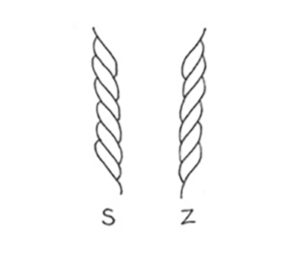
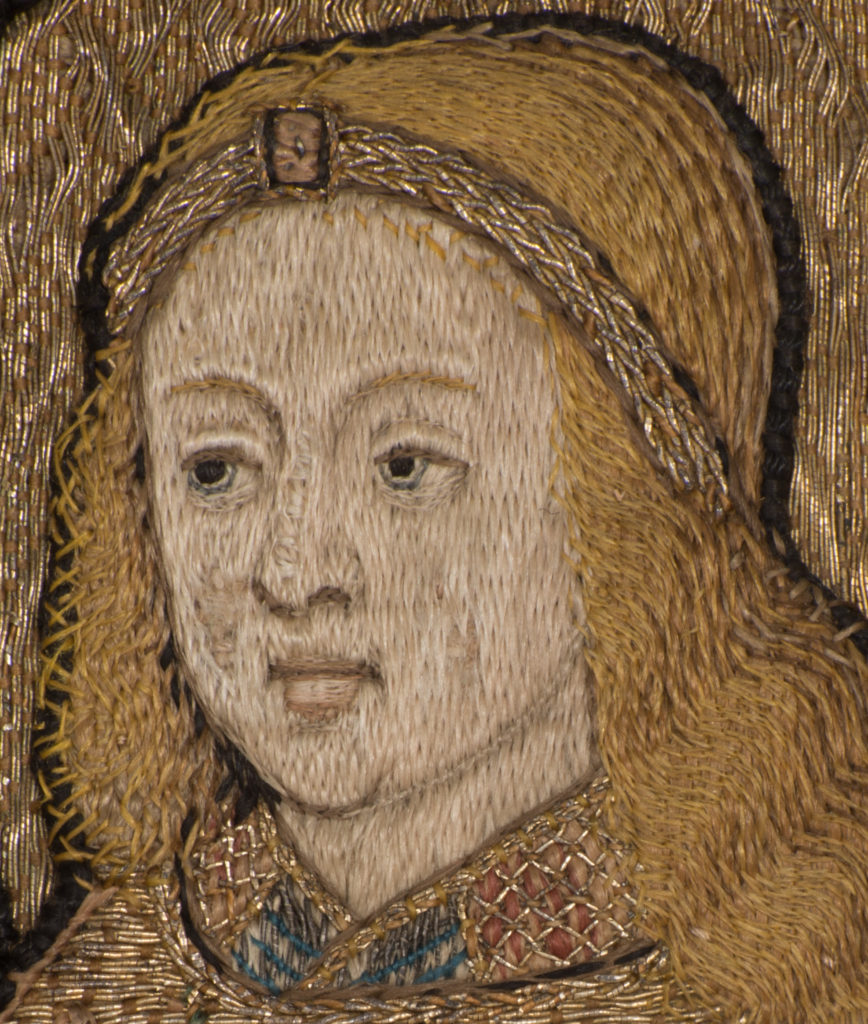
Faces. The hands and faces of all the figures are worked in a vertical Burden stitch in coloured silk threads using the regular weave of the background linen as a guide. The shading that has been achieved here is very skilled due to the regular, counted nature of Burden stitch. Fine details such as the eyes are worked in Satin stitch with Split and Stem stitch outlines.
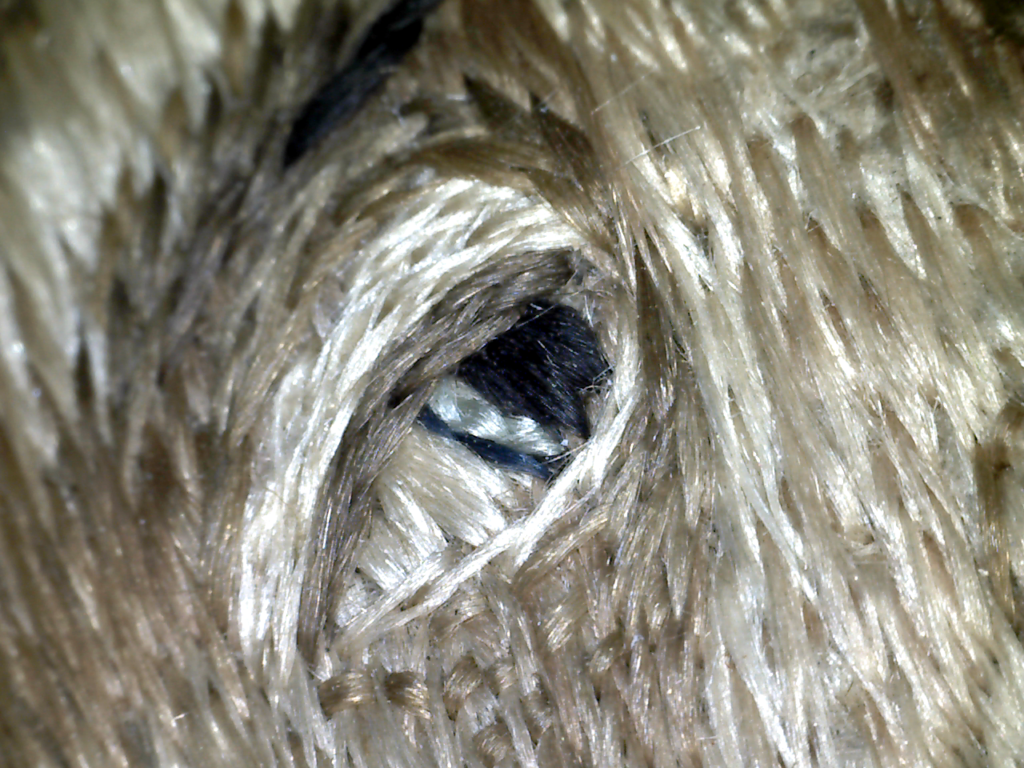
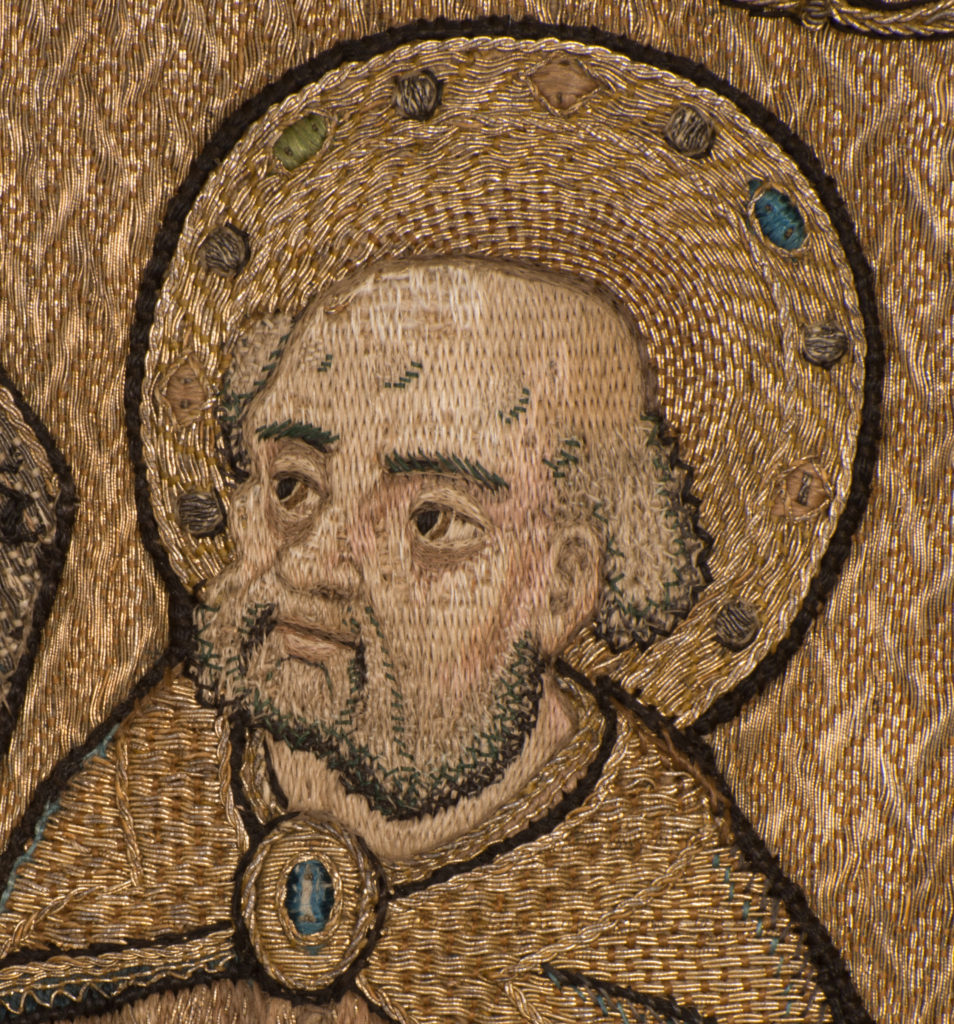
The style of the embroidery used for the faces is quite uncommon and stylised due to the Burden stitch and the angled fleck stitches used for the hair. They are also very finely worked and the shaded detail attained within the Burden stitch has been very skilfully achieved. The skill required to achieve this level of detail would only have been possible through many years of practice and natural ability; it is likely therefore that the faces were all worked by one individual. Working with good light, a skilled embroiderer would probably be able to execute a face of this size within two to three days.
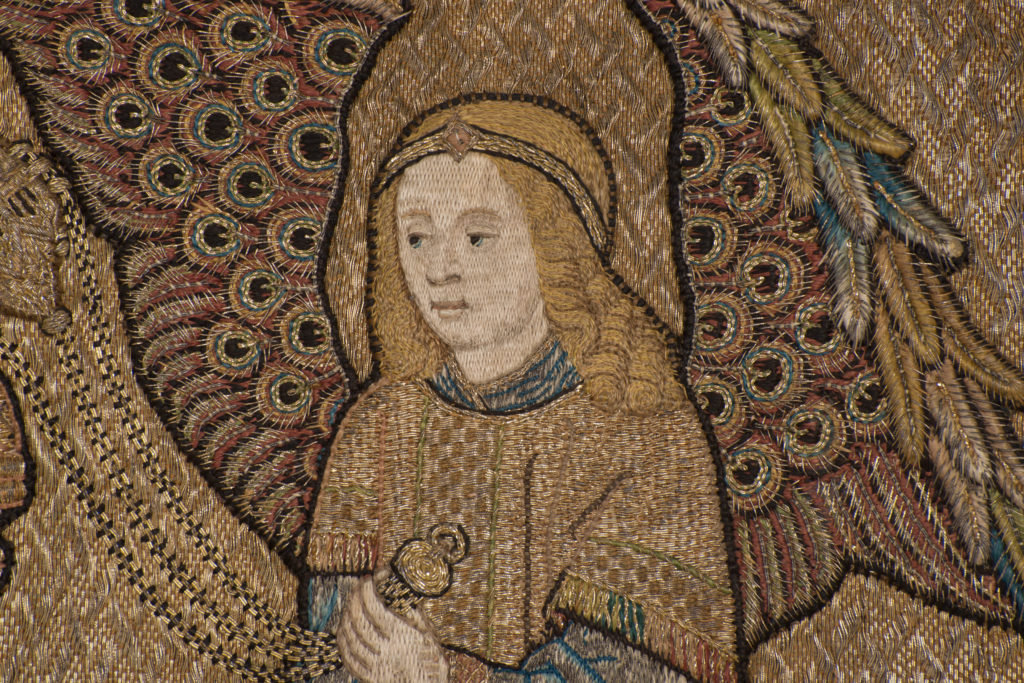
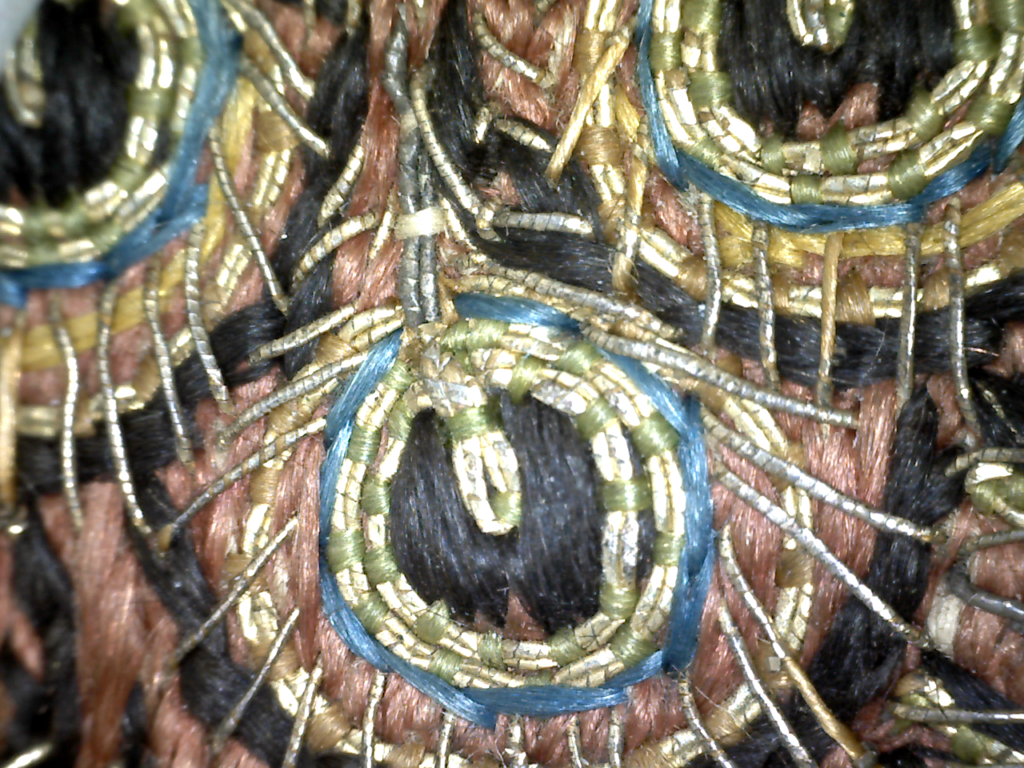
Goldwork. A gold thread is not very pure in gold as this would be too soft to work with. Today a gilt thread is typically defined as 0.5 % gold, whereas a gold thread is only 2 % gold. The gold is alloyed with silver and copper to produce a still delicate but workable thread. A gilt thread is more yellow in colour than a gold one, which is richer and more orange.
All metal threads will tarnish and in a remarkably short period of time, but the higher the percentage of gold, the more golden coloured the thread will remain. The embroiderers would undoubtedly have known how metal threads tarnish and would have used this characteristic to enhance the design.
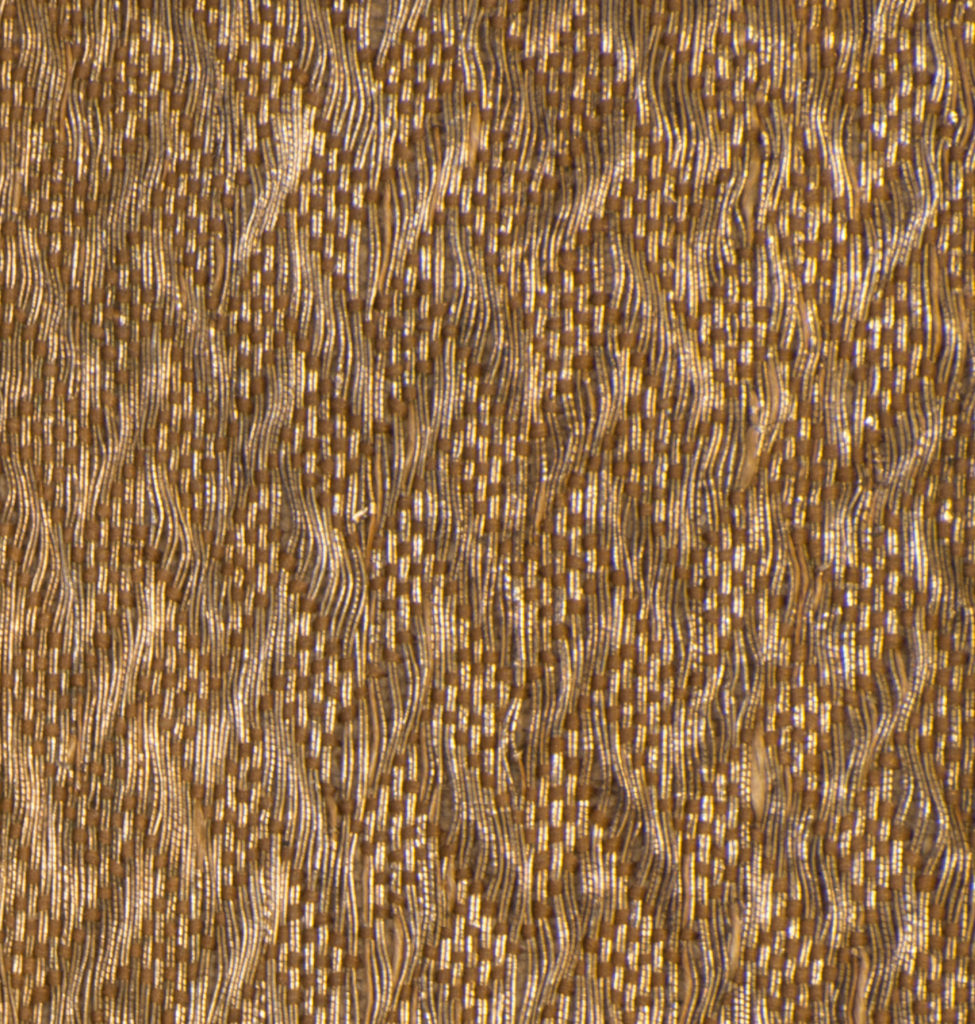
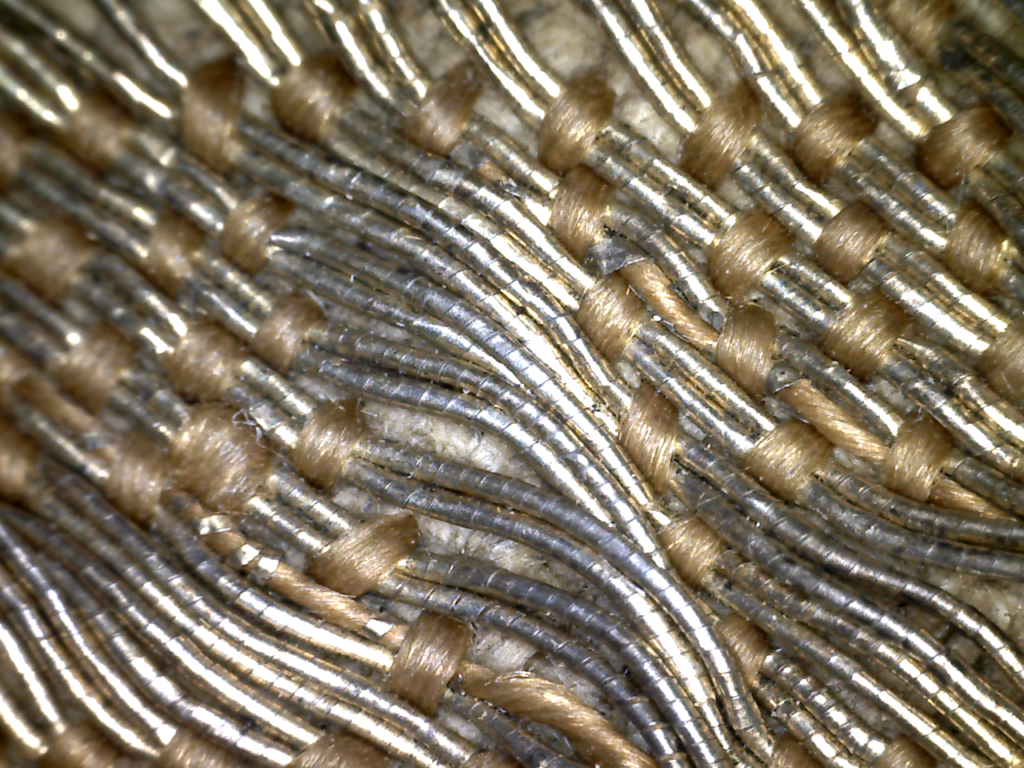
The majority of the gold and silver threads used on the Pall are couched Passing. The upper parts of the backgrounds of each panel are worked in double lengths of gold Passing couched in rows in a diaper pattern. The Passing threads are couched in place using a fine coloured silk thread and use the even weave of the linen support fabric to count out the placement of the couching stitches in a diaper pattern.
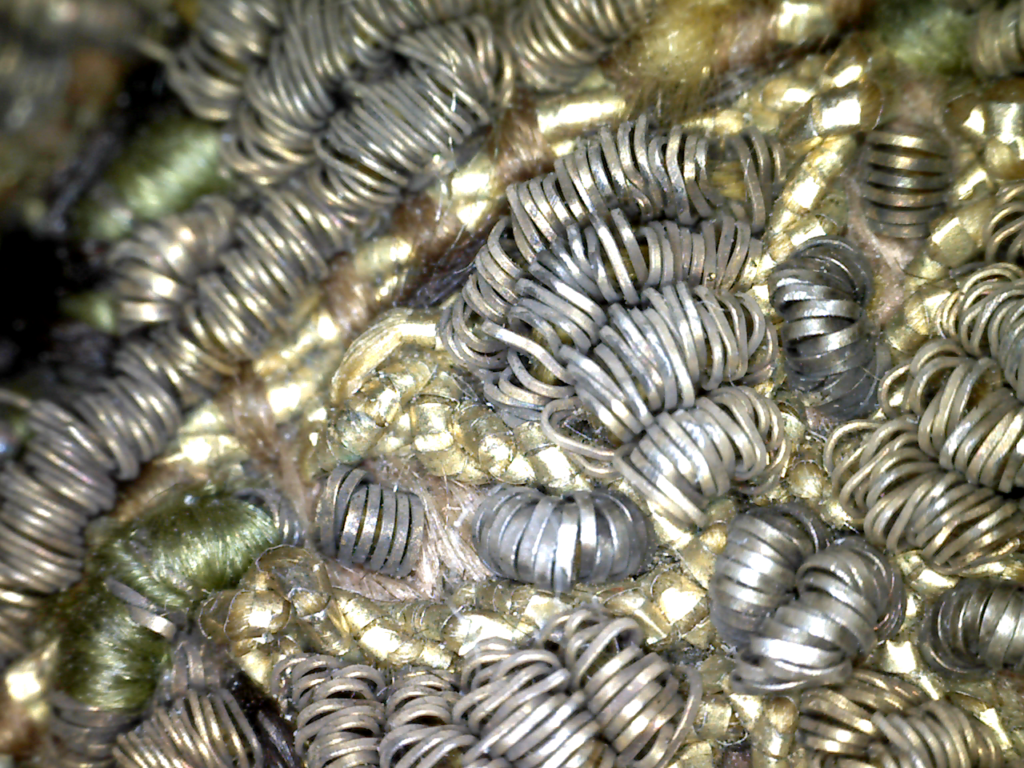
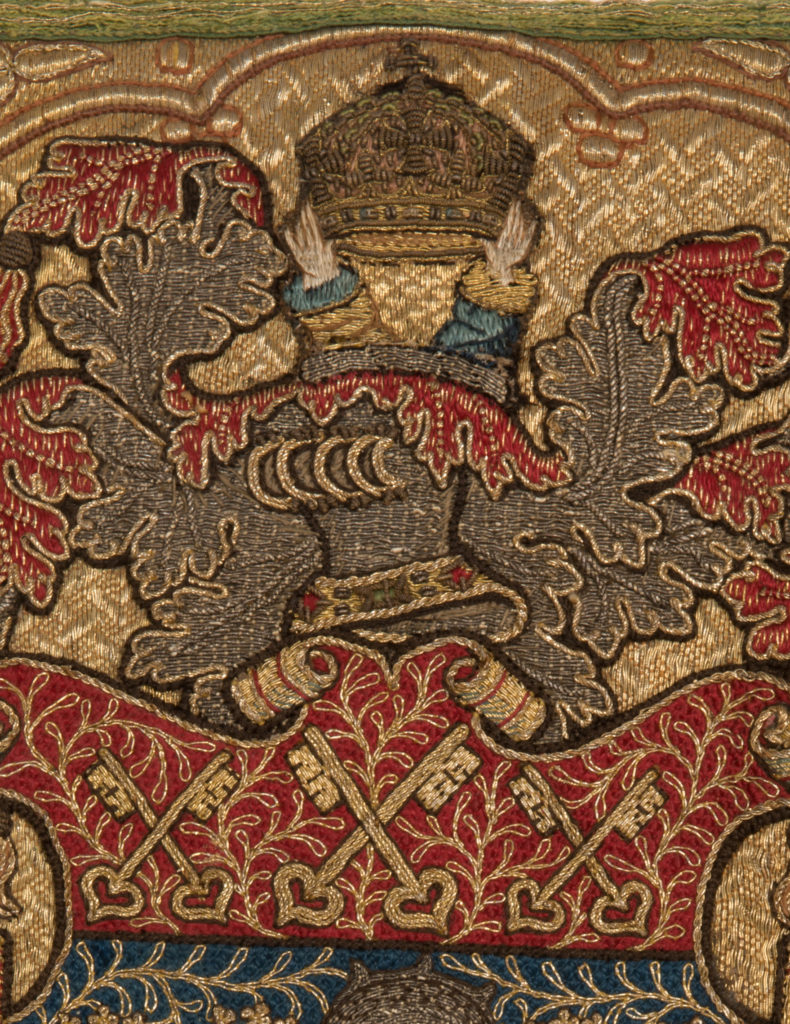
Two types of check purl can be seen in this magnified detail (above) of the crown motif on the Coat of Arms; smooth, produced by gold wire being spun around a cylindrical ‘needle’, and bright, where the wire is spun around an angled ‘needle’ forming a faceted length of metal thread.
Check Purl threads are made by drawing out a very fine wire of metal that is then spun around a ‘needle’ forming a very fine length of gold tubing. This tightly coiled and very fine spring can then be cut into short lengths and sewn down with a waxed sewing thread passing through the centre of the tubing in a similar manner to a bead. This ‘bead’ however is flexible so can also be looped or laid over padding if desired.
The Cutwork technique is the most delicate and fragile of this type of embroidery and so these areas are generally the very last to be worked. The gold thread of the Check Purl is vulnerable due to the lack of a silk core ‘padding’ out the thread. This can mean that the Check Purl thread is often crushed and ‘cracked’ where the thread has become damaged after application resulting in an opening up of the spiral of the thread. It is incredibly easy to ‘crack’ a Check Purl thread even by a very slight knock. The spiral nature of the thread and the cut ends to the lengths make it also vulnerable to being snagged and pulled leaving an unsightly tail of overstretched gold wire. The Check Purl on the crown motifs has been skilfully applied and well cared for so there is very little damage to the work other than tarnishing through the passage of time.
Construction. The construction of the embroidered panels is complex. Each figure and Coat of Arms has been worked as a separate element on a secondary embroidery frame before being cut out and applied as a motif on to the background. The raw edges of the motifs have been covered with either a couched silk or a gold Twist thread before the final details have been stitched.
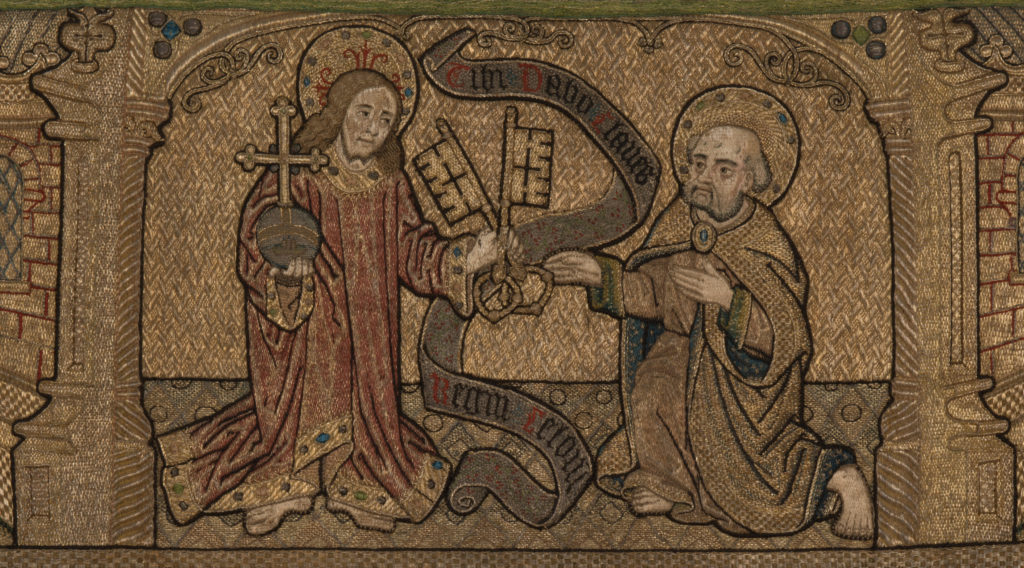
Working the figures and other elements separately and then putting it all together at the end allows for the maximum number of people to work on the piece at any one time as there is no jostling for space at the embroidery frame. If worked as one large panel with no appliqué patches, a maximum of probably three people per side panel could be employed. It may have been possible to add a further three seated on the other side of the frame at the very beginning when there were still large areas to be worked but this would be for a very limited time only. Splitting it up means more people can work on the embroidery and thus the work can be completed more quickly.
Even so given the amount of very dense embroidery that completely covers absolutely every surface of the side panels and the fact that it could only be worked during daylight hours, it would have probably have taken a number of embroiderers at least six months of solid work to actually embroider and construct the Pall. Time would also need to be added for the ordering and making of the metal threads, the making of the braids and fringes and the weaving of the Cloth of Gold for the top of the piece and for other commissions. Therefore it is not surprising the Pall probably took several years to complete.
Photos by David Fernandes at https://fernandes.photography/
Photomicrographs using DinoLite Digital Microscope © Zenzie Tinker Conservation
Further reading.
Arnott, H. (2015) ‘A Study of the Embroidered Fishmongers Company Pall’, Fishmongers’ Hall, London
Browne, C., Davies, G. and Michael, M. A. (2016) ‘English Medieval Embroidery Opus Anglicanum’, V&A Publishing, London
Franklin, T. (2002) ‘New Ideas in Goldwork’, BT Batsford Ltd, London
Monnas, L. (2012) ‘Renaissance Velvets’, V&A Publishing, London
Staniland, K. (1991) ‘Medieval Craftsmen – Embroiderers’, British Museum Press, London
Saunders, S. (1998) ‘Royal School of Needlework Embroidery Techniques’, Batsford Ltd, London
Schoeser, M. (1998) ‘English Church Embroidery 1833 – 1953 – The Watts Book of Embroidery’. Watts and Co Ltd, London
Thomas, M. (1934) ‘Mary Thomas’s Dictionary of Embroidery Stitches’, Hodder & Stoughton Limited, London
